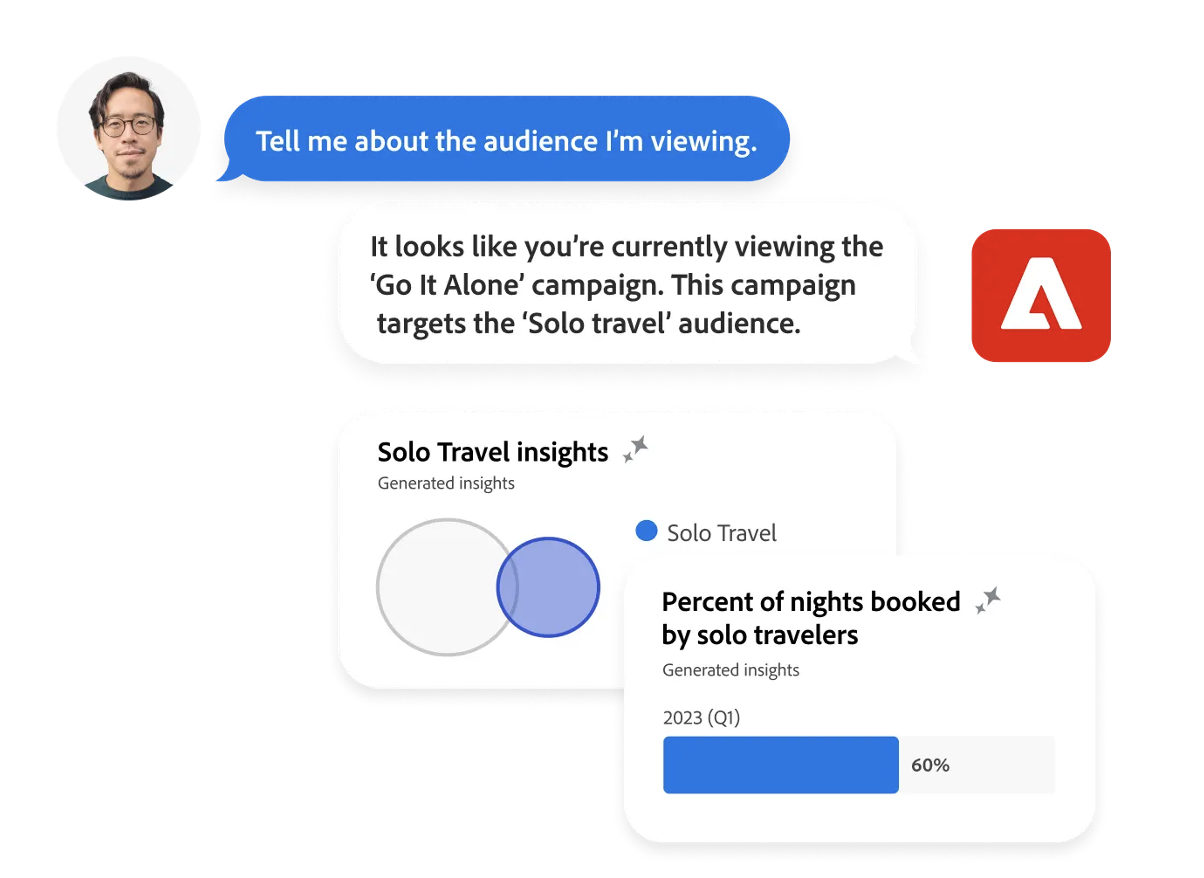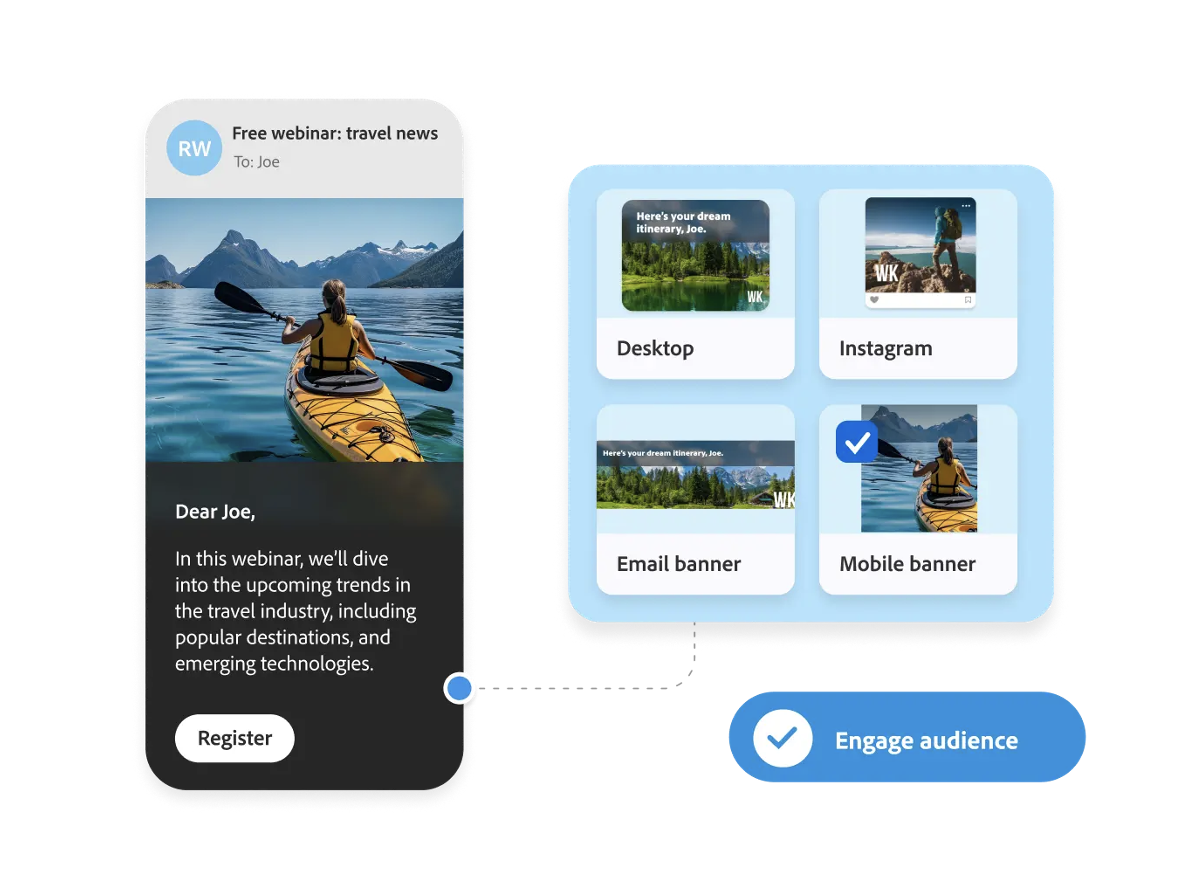
What is Adobe Experience Cloud? The Ultimate Guide


Adobe Experience Cloud is a comprehensive suite designed to enhance customer experiences across multiple touchpoints. It offers tools for analytics, social media, advertising, and web experience management. This ensures businesses can both delivery and manage personalized journey for their customers.
One unique feature is its ability to centralize and standardize customer data. This helps organizations use data science and machine learning to improve interactions with their primary audience. The platform's flexibility allows it to serve both B2B and B2C channels effectively.
Businesses looking to stay ahead in the digital age will find immense value in the Adobe Experience Cloud. By leaning on its powerful tools and integrations, companies can enhance the customer experience, streamline operations, and ultimately drive better business results.
Key Takeaways
Adobe Experience Cloud helps deliver personalized customer experiences through powerful tools.
It centralizes customer data and uses machine learning for better interactions.
Businesses can stay a few steps ahead of the competition and technological trends.
Understanding Adobe Experience Cloud
Adobe Experience Cloud is a collection of integrated applications and services that help businesses create, manage, and optimize customer experiences across all channels. It provides tools for insights, content, and customer engagement.
The Adobe Experience Platform is built to unify and manage customer data, delivering real-time customer profiles mixed with AI-driven insights. Since personal and relevant experiences are more in-demand than ever, these tools take out the busywork without compromising on results.
Businesses depend on the Adobe Experience Cloud to better understand their customers and create more personalized marketing campaigns. The Adobe Experience Platform supports various functions including analytics, content management, targeted campaigns, and advertising.

Historical Background and Evolution
Adobe Experience Cloud has evolved significantly since its inception. Originally, Adobe offered separate tools for digital marketing and content creation. Over time, these tools were integrated into a single platform to provide a more cohesive experience.
This integration has allowed Adobe to offer advanced features and improved scalability without creating extra work for businesses.
Adobe has continually added new capabilities and services to the Experience Cloud through acquisitions and internal development. This has helped keep the platform at the forefront of digital marketing and customer experience management.
Key Benefits for Businesses
One of the main advantages of the Adobe Experience Platform is the ability to gain a unified view of the customer across all touchpoints. This holistic approach enables businesses to create more targeted and effective marketing campaigns without missing any crucial details.
Another significant benefit is the platform's real-time data analytics. This feature allows businesses to quickly adapt to changing market conditions and customer behaviors. The Adobe Experience Cloud also offers powerful content management and personalization tools, making it easier to deliver relevant content to customers.
Overall, this platform enhances the ability of businesses to engage with customers, improve customer satisfaction, and drive growth. Getting a grasp on the complete customer lifecycle has never been easier.
Core Components of Adobe Experience Cloud
Adobe Experience Cloud offers a range of tools designed to help businesses optimize their customer experiences. Their key components include powerful analytics, content management, campaign management, and commerce solutions.
Adobe Analytics
Adobe Analytics is a key part of the Adobe Experience Cloud, offering detailed data insights that enable businesses to understand their customers' behavior. Users can track important metrics like page views, core web vitals, and conversion events.
The platform also supports segmentation, which allows businesses to personalize experiences based on user behavior. Real-time reporting and predictive analytics help in making better data-driven decisions, improving overall customer journeys.

Adobe Experience Manager
Adobe Experience Manager (AEM) is a powerful content management system that helps create and deliver personalized digital experiences across channels. AEM's core components include easy-to-use templates, workflows, and integrations.
It supports content versioning and makes it easy for marketers to manage and deliver content without extensive technical knowledge. AEM can be deployed on-premise or as a cloud service, offering businesses both flexibility and scalability.
Adobe Campaign
Adobe Campaign is designed to manage and automate all aspects of customer communication. The tool allows businesses to create, manage, and deliver personalized campaigns across web and mobile apps, email, social, and offline channels.
It supports advanced segmentation and real-time interaction management to ensure messages are relevant and timely. By integrating with Adobe Experience Cloud, Campaign helps to maintain a consistent customer experience across all touchpoints, enhancing engagement and conversion rates.
Adobe Commerce
Adobe Commerce provides a comprehensive platform for online retail and business-to-business (B2B) commerce. It offers tools for building customizable e-commerce websites, managing product catalogs, processing orders, and handling customer service.
Features like AI-driven product recommendations and seamless integrations with marketing and analytics tools help businesses deliver personalized shopping experiences. The platform supports multiple payment gateways and shipping methods, ensuring a smooth customer journey from browsing to purchasing.
Additional Tools and Features
Adobe Experience Cloud offers a range of accessible tools to enhance customer experiences through data-driven insights, real-time personalization, and detailed journey analytics.
Adobe Real-Time CDP
Adobe Real-Time Customer Data Platform (CDP) centralizes customer data from multiple sources into individual customer profiles. These profiles use AI to update in real-time, enabling brands to deliver personalized experiences.
It can integrate with various systems, as well, ensuring consistent and up-to-date customer data. This function allows businesses to segment their audience accurately and create tailored marketing strategies. When nearly half of customers expect some level of personalization when ordering services or products, this feature can't be overlooked.
Using this platform, companies can more easily optimize customer interactions through comprehensive profiles, both online and offline. Enhanced by data science capabilities, Adobe Real-Time CDP makes it much easier to predict customer behavior and personalize engagement.
Customer Journey Analytics
Customer Journey Analytics provides in-depth insights into customer behavior across all touchpoints. By unifying data from various sources, it gives a more complete view of the customer journey. This tool uses AI to identify subtle trends and patterns that could be easily overlooked.
Customer Journey Analytics allows for the visualization of journeys, enabling businesses to pinpoint exactly where customers drop off or experience issues. Through these insights, companies can optimize their processes and gradually improve customer retention. It supports detailed reporting and visualization, allowing for a clear understanding of how different marketing efforts impact the customer journey.
Adobe Target
Adobe Target is a robust tool for personalization and optimization. It enables businesses to test and target content to specific customer segments, ensuring personalized experiences. With its AI capabilities, Adobe Target can predict the best content for each customer.
The platform supports A/B testing, multivariate testing, and automated personalization. By continuously optimizing content and offers, businesses can enhance customer satisfaction and increase revenue. Adobe Target also integrates with other Adobe Experience Cloud tools.
Audience Manager
Audience Manager is a data management platform that helps businesses build unique audience profiles. It uses data from multiple channels, allowing for accurate and effective target segmentation. Audience Manager provides tools for managing and activating these profiles with little effort.
The platform allows the creation of custom segments based on detailed customer data. This can be leveraged for targeted advertising and personalized content delivery. Audience Manager enhances the ability to reach the right audience by ensuring that marketing messages are tailored and relevant.
Integrations and Ecosystem
Adobe Experience Cloud is designed to work seamlessly within Adobe's suite of products (and also integrates well with third-party applications). This creates a unified ecosystem where businesses can efficiently manage their digital assets and customer data.
Seamless Integration with Other Adobe Products
Adobe Experience Cloud integrates smoothly with other Adobe solutions like Adobe Analytics, Adobe Target, and Creative Cloud. These integrations enable businesses to gain deeper insights and deliver personalized experiences. For instance, Adobe Analytics provides data that can be used in Adobe Target to create more tailored marketing campaigns.
Another vital connection is with Adobe Experience Manager. This integration helps in managing web content and delivering a consistent customer journey across multiple channels. Document Cloud integration ensures that all documents and signatures are easily accessible and manageable within the ecosystem.
Compatibility with Third-Party Applications
Adobe Experience Cloud offers robust APIs, making it compatible with various third-party applications. Businesses can integrate CRM systems, social media platforms, and other marketing tools.
This compatibility ensures that companies can use their favorite tools without sacrificing the benefits of Adobe's powerhouse. For example, integrating with popular CRM systems like Salesforce allows for seamless data flow between customer profiles and marketing campaigns.
Benefits of a Unified Ecosystem
Your first benefit is unifying data management across different platforms. All of your customer data, whether from Adobe Analytics or third-party apps, can be centralized, providing a comprehensive view of customer behavior.
Secondly, it enhances productivity. Teams can collaborate better when all tools and data are integrated. They can switch between Creative Cloud for design and Adobe Experience Manager for content without disruptions.
Thirdly, it improves the accuracy of analytics and insights. With all data sources connected, businesses gain more accurate and actionable insights.
By integrating these tools into a unified ecosystem, businesses can streamline their operations, enhance productivity, and deliver a better customer experience.
For more details, you can visit Adobe's page dedicated to integrations with Experience Cloud applications. Another useful resource is the Customer Data Platform for understanding how real-time profiles enhance personalization.
Comparing Adobe Experience Cloud to Competitors
Adobe Experience Cloud is a powerful platform, but it's essential to compare it with its competitors to understand its unique advantages. Key areas include integration, AI capabilities, analytics, and marketing automation.
Integration and Flexibility Advantages
Adobe Experience Cloud stands out for its seamless integration with other Adobe products. Users can connect industry-standard tools like Photoshop and Illustrator with their marketing efforts.
Competitors like HubSpot and Salesforce offer robust tools, but Adobe's integration is more refined. The platform's flexibility allows businesses to customize workflows and add third-party applications. This ensures that various marketing and analytics tools work together smoothly.
AI and Machine Learning Capabilities with Adobe Sensei
Adobe Sensei, an AI and machine learning engine, gives Adobe Experience Cloud a significant advantage. Sensei enhances content creation by auto-tagging and suggesting improvements based on analytics.
AI-driven insights help in personalizing customer experiences more effectively than many competitors. While HubSpot and Salesforce have AI capabilities, Adobe Sensei integrates deeply with the entire Adobe suite.
Sensei also automates repetitive tasks, freeing up time for creative and strategic work.
Comprehensive Analytics and Content Management
Adobe Experience Cloud offers robust analytics tools that give in-depth insights into customer behavior. The platform's analytics capabilities surpass many competitors like Mailchimp and HubSpot.
Users can track and measure the performance of their campaigns with precision. Content management is also enhanced through Adobe Experience Manager. This tool allows for streamlined content creation and delivery, ensuring consistency across all channels.
Competitors may offer useful content management features, but the Adobe Experience Platform provides more control and customization across the board.
Marketing Automation and Customer Journey Management
Marketing automation is a strong suit of Adobe Experience Cloud. The platform provides tools for automating email campaigns, social media posts, and more.
Customer journey management is enhanced through real-time data analytics. Competitors like Salesforce and HubSpot offer similar features, but Adobe's tools are more tightly integrated.
Overall, this tool helps businesses tailor marketing strategies to individual customer needs. The platform's automation capabilities ensure that marketing efforts are timely and relevant, two key ingredients to personalization.
Getting Started with Adobe Experience Cloud
It's easier to get started once you know the implementation process and the available resources for training.
Implementation Process
Implementing Adobe Experience Cloud involves several key steps. First, users need to set up their Experience Cloud ID. This ID is crucial for accurate tracking and data integration. Adobe recommends synchronizing customer IDs within Experience Cloud to keep your data as consistent as possible.
Next, configuring core services such as Audience Manager helps in real-time audience profiling. Data used here will reside in the United States on Audience Manager servers.
Lastly, linking services like Analytics and Adobe Target will create a unified customer experience and more accurate reporting.
Training and Resources Available
Adobe offers a multitude of resources to assist users in getting started. The Introduction to Adobe Experience Platform course is particularly helpful for new users.
Training programs cover an overview of the platform’s capabilities, use cases, and basic architecture. Resources also emphasize the relationship of Experience Cloud with other Adobe products.
Additionally, Adobe provides support through Experience League, where users can access guides, tutorials, and engage with the community for peer support and expert advice.
Tips for Maximizing the Benefits
To get the most out of Adobe Experience Cloud, follow these tips.
Regularly update and align your customer data. Ensure that your IDs are synced to maintain consistency at all times.
Use AI-driven insights within the platform to personalize customer interactions. This helps in delivering the right experience at the right time across various channels.
Engage in continuous learning via Adobe’s training programs and forums. Staying updated with the new Adobe Experience Platform updates can offer additional advantages you didn't even realize were possible.
How Rightpoint Can Help
It's difficult to keep up with digital marketing tools at the best of times. We're here to make sure you get the most out of your marketing automation platform at all times.
We regularly use Adobe's reporting and analytics tools to help our clients tackle their business hurdles. Our specialties span across commerce, customer experience strategy, the employee experience, and much more. Instead of disrupting your business operations, our pre-existing integration with Adobe means our solution areas weave seamlessly into your workflow.
When you partner with us, you equip yourself with the ability to finally make your customer data platform work for you.
Your Marketing Automation Platform Should Work For You, Not Against You
Adobe Experience Cloud offers a vast range of tools designed to enhance customer experiences across all digital channels. It enables businesses to manage and deliver personalized journeys for both B2B and B2C customers with less effort.
Its key features include analytics, marketing automation, and content optimization. These tools help businesses gather insights, improve engagement, and drive growth all in one convenient place. The platform's dedication to advanced technologies like AI and machine learning also make it easier to understand dynamic customer behavior.
Businesses can also benefit from future trends in digital experience management. These trends include more integrated data systems, improved personalization, and enhanced predictive analytics.
By using Adobe Experience Cloud, companies are able to stay ahead in the rapidly evolving digital landscape. This ensures they not only meet, but exceed customer expectations.
Frequently Asked Questions
Adobe Experience Cloud offers various tools for personalized customer experiences, manage digital content, and integrate cloud services. Below are a few common questions to help you get a better idea of what to expect.
How does Adobe Experience Cloud enhance customer experiences?
By providing integrated tools for content, marketing, and analytics, Adobe Experience Cloud helps businesses create personalized customer experiences. This suite of tools supports real-time data and insights, allowing for smart, relevant, and timely marketing campaigns.
What are the key components of Adobe Experience Cloud?
Adobe Experience Cloud consists of several major components, including Adobe Analytics, Adobe Audience Manager, Adobe Campaign, Adobe Commerce, Adobe Experience Manager, and Adobe Target.
Each component serves a unique function in digital marketing, content management, and customer engagement.
How is Adobe Experience Manager integrated within Adobe Experience Cloud?
AEM is integrated to streamline content creation and management. AEM allows for the efficient handling of websites, mobile apps, and forms. This integration ensures that all digital assets are consistent and easily accessible across the entire marketing ecosystem.
What are the pricing models for Adobe Experience Cloud products?
Pricing for Adobe Experience Cloud products typically depends on the specific services and number of users. Businesses can opt for different subscription tiers based on their needs. For precise pricing details, contact Adobe sales representatives directly.
Can Adobe Experience Platform be differentiated from Adobe Experience Cloud in terms of capabilities?
Yes, Adobe Experience Platform primarily focuses on data management and real-time customer profiles. While Adobe Experience Cloud includes a broader suite of marketing and content management tools, the Platform serves as the data foundation that powers customer insights across all the other services.
What kind of architecture underpins the Adobe Experience Platform?
The Adobe Experience Platform utilizes a microservices-based architecture, ensuring flexibility and scalability. It uses APIs for seamless integration with other systems, as well as supports data ingestion and processing from various sources.


